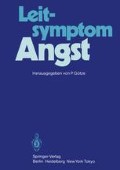Zusammenfassung
In der psychophysiologisch orientierten Angstforschung (vgl. zusammenfassende Darstellung von Larbig u. Birbaumer 1980) werden mehrere Betrachtungs- und Wirkebenen unterschieden, die sich gegenseitig beeinflussen und deren Prozesse und Funktionseigenheiten voneinander abhängig sind. Diese unterschiedlichen Organisationsstufen werden mit dem Dreiebenenkonzept des Verhaltens beschrieben, das für eine naturwissenschaftlich fundierte Definition des Angstphänomens von großem Nutzen ist.
Dieser Artikel ist eine veränderte und erneuerte Fassung von Larbig u. Birbaumer 1980
Access this chapter
Tax calculation will be finalised at checkout
Purchases are for personal use only
Preview
Unable to display preview. Download preview PDF.
Literatur
Agras WS, Chapin HN, Oliveau DC (1972) The natural history of phobias: Course and prognosis. Arch Gen Psychiatry 26:315–317
Bettelheim B (1960) The informed heart. Free Press, New York
Birbaumer N (1975) Physiologische Psychologie. Springer, Berlin Heidelberg New York
Birbaumer N (1977) Psychophysiologic der Angst. Urban & Schwarzenberg, München
Birbaumer N, Kimmel HD (eds) (1978) Biofeedback and self-regulation. Erlbaum, Hillsdale
Birbaumer N, Tunner W (1971) EEG, evozierte Potentiale und Desensibilisierung. Arch Psychol 123:225–234
Bowlby J (1973) Attachment and loss, vol II. Separation, anxiety anger. Basic, New York
Delgado JM (1971) Gehirnschrittmacher. Ullstein, Frankfurt
Dollard J, Miller NE (1950) Personality and psychotherapy. McGraw-Hill, New York
Eibl-Eibesfeldt I (1972) Grundriß der vergleichenden Verhaltensforschung. Piper, München
Ekman P, Friesen W (1975) Unmasking the face. Prentice Hall, Englewood-Cliffs
Engel GL, Schmale AH (1972) Conservation-withdrawal: A primary regulatory process for organismic homeostasis. In: Ciba Foundation Symposium 8 Physiology, emotion and psychosomatic illness. Elsevier, Amsterdam pp 57–75
Epstein S (1967) Versuch einer Theorie der Angst. In: Birbaumer N (Hrsg) Psychophysiologic der Angst. Urban & Schwarzenberg, München, S 208–266
Ford CV (1975) The Pueblo incident: Psychophysiological response to severe stress. In: Sarason IG, Spielberger CD (eds) Stress and anxiety, vol 2. Wiley, New York
Freud S (1926) Hemmung, Symptom und Angst. Gesammelte Werke, Bd XIV. Fischer, Frankfurt
Friedman DB, Chodoff P, Mason JW, Hamburg DA (1963) Behavioral observations on parents anticipating the death of a child. Pediatrics 32:610–625
Gallistel CR (1973) Self-stimulation: The neurophysiology of reward and motivation. In: Deutsch JA (ed) The physiological basis of memory. Academic Press, New York, pp 176–267
Gellhorn E (1967) Principles of autonomic-somatic integrations. University of Minnesota Press, Minneapolis
Gray JA (1971) Angst und Stress. Kindler, München
Grinker RR, Spiegel JP (1945) Men under stress. McGraw-Hill, New York
Hare RD (1975) Psychopathy. In: Venables P, Christie M (eds) Research in psychophysiology. Wiley, New York, pp 325–348
Hohmann GW (1966) Some effects of spinal cord lesions on experienced emotional feelings. Psychophysiology 3:143–156
Izard C (1977) Human emotions. Plenum, New York
Lader MH (1975) The psychophysiology of mental illness. Routledge & Kegan, London
Larbig W (1982) Schmerz. Grundlagen — Forschung — Therapie. Kohlhammer, Stuttgart
Larbig W, Birbaumer N (1980) Angst. In: Wittling W (Hrsg) Hoffmann & Campe, Hamburg (Handbuch der Klinischen Psychologie, Bd 4 Ätiologie gestörten Verhaltens), S 182–243
Lazarus RS, Averill JR (1972) Emotion and cognitions: With special reference to anxiety. In: Spielberger CD (ed) Anxiety. Current trends in theory and research, vol 2. Academic Press, New York London, pp 242–284
Lewis M, Rosenblum LA (1974) The origins of fear. Wiley, New York
Marks I (1977) Clinical phenomenon in search for laboratory models. In: Maser SD, Seligman MEP (eds) Psychopathology. Freeman, San Francisco, pp 174–213
Miller NE (1976) Learning, stress and psychosomatic symptoms. Acta Neurobiol Exp 36:141–156
Mowrer OH (1939) A stimulus-response analysis of anxiety and its role as a reinforcing agent. Psychol Rev 46:553–565
Mulholland T (1973) Objective EEG methods for studying covertshifts of visual attention. In: Mc Guigan FS, Schoonover RA (eds) The psychophysiology of thinking. Academic Press, New York, pp 109–145
Olds J (1977) Drives and reinforcements. Raven, New York
Penfield W, Jasper H (1954) Epilepsy and the functional anatomy of the human brain. Little Brown, Boston
Rachman S (1974) Biologically significant fears. Comment to A Öhman, M Fredricson, K Hughdahl. Behav Anal Modif 2:234–239
Rockstroh B, Elbert T, Lutzenberger W, Birbaumer N (1979) Slow cortical potentials under conditions of uncontrollability. Psychophysiology 6:374–380
Routtenberg A (1968) The two-arousal hypothesis. Reticular formation and limbic system. Psychol Rev 75:51–80
Sarason IG (1972) Experimental approaches to test anxiety: Attention and the uses of information. In: Spielberger C (ed) Anxiety. Current trends in theory and research, vol 2. Academic Press, New York, pp 383–405
Sartory G, Eysenck HJ (1976) Strain differentials in acquisition and extinction of fear réponses in rats. Psychol Rep 38:163–187
Schultz-Hencke H (1970) Lehrbuch der analytischen Psychotherapie. Thieme, Stuttgart
Seligman MEP (1975) Helplessness. Freeman, San Francisco
Seligman MEP, Hager EE (eds) (1972) Biological bounderies of learning. Appleton, New York
Spitz RA (1946) Anaclitic depression. The psychoanalytic study of the child. 2:313–347
Stein L, Wise DC, Belluzzi JD (1977) Neuropharmacology of reward and punishment. In: Iverson LL, Iverson SD, Snyder SH (eds) Handbook of psychopharmacology, vol 8. Drugs, Neurotransmitters and Behavior. Plenum, New York, pp 25–54
Watson JB, Rayner R (1920) Conditiones emotional reactions. J Exp Psychol 3:1–14
Weiss JM, Glazer HI, Pokorecky LA (1976) Coping behavior and neurochemical changes. In: Serban G, Kling A (eds) Animal models in psychobiology, Plenum, New York, pp 141–173
Editor information
Editors and Affiliations
Rights and permissions
Copyright information
© 1984 Springer-Verlag Berlin Heidelberg
About this chapter
Cite this chapter
Larbig, W., Birbaumer, N. (1984). Psychophysiologische Aspekte der Angst. In: Götze, P. (eds) Leitsymptom Angst. Springer, Berlin, Heidelberg. https://doi.org/10.1007/978-3-642-93259-5_11
Download citation
DOI: https://doi.org/10.1007/978-3-642-93259-5_11
Publisher Name: Springer, Berlin, Heidelberg
Print ISBN: 978-3-540-13048-2
Online ISBN: 978-3-642-93259-5
eBook Packages: Springer Book Archive

